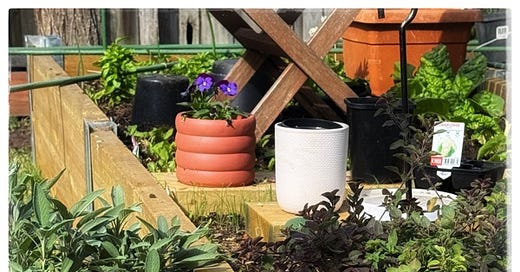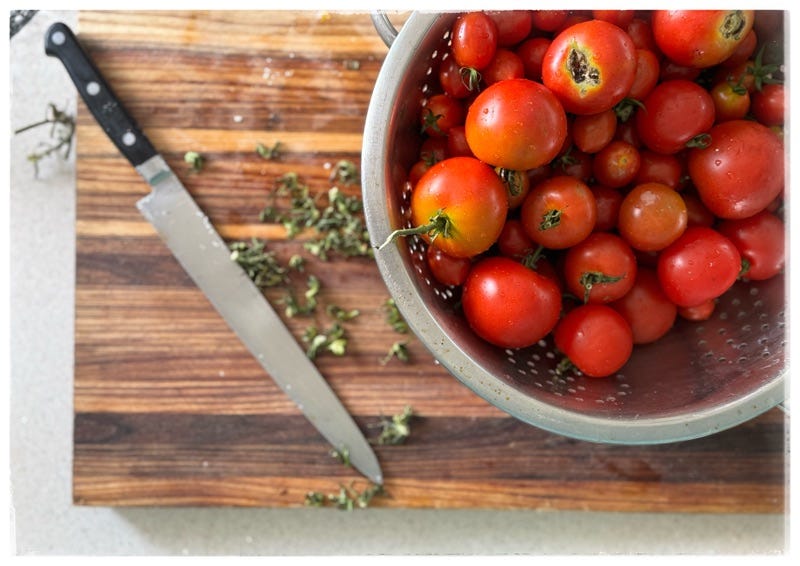a little advice for beginner gardeners.
I have had a number of queries lately about starting your garden without spending too much money.
Grow what you eat.
Grow what you cook.
Grow what you intend to store for winter.
There are the three pivots in a vegetable garden. And my most important advice.
Growing. Cooking. Storing. So grow what you love to cook and eat.
For most of you reading here, it is Spring - my country garden in Illinois is in Spring (the 300 cloves of garlic I planted in the fall are up and growing well.)
For some of you (like me at the moment in Australia) it is Autumn - and here in Melbourne in the city garden I am planting cold weather plants like brassicas, root crops, more herbs (I never have enough parsley) and trees in my city garden with a country heart.
🐞 So, what do you cook?
Gardeners are the people who make big green salads at every dinner, cook with fresh herbs, chop endless amounts of courgette into stir frys, make broccoli soup when they cannot think of one more thing to do with broccoli, then store their excess for the winter.
So as you set up a new garden keep in mind what you would love to eat. There is simply no point in growing aubergine if you don’t love to eat it. I do. And I do. I love a good eggplant parmigiana. Especially with my own tomatoes.
I hate capsicums - sweet peppers - so I don’t grow them. Though they are easy to grow and you only need two plants per family! Except me. I need none at all.
🐞How much space do you have. Be very honest with yourself about your space. You will not be able to grow everything. I simply don’t have enough room to grow butternut (which I love) but I will dig up lawn for space for tomatoes. Almost all my recipes have a summer tomato sauce component. I eat a lot of tomatoes raw or in sauces so in my new garden I am preparing a good well fertilized space for spring plantings of tomatoes.
🐞Stagger your plantings. No family kitchen wants ten heads of broccoli in the same day. Sow a few more every few weeks.
🐞Research your geographical environment. Knowing your zone will help determine what and when you plant. So check what Zone you are in. (An international discussion and link to zones). Check the first and last frost dates in your region. These are critical dates for planning a garden. The changes in the climate are impacting planting times so stay current.
🐞Growing medium (soil) for pots and for conditioning the soil will be your main expense. Good nourished soil is essential. If you can partner with a neighbour and buy a cubic metre of soil or mushroom compost it is so much cheaper.
Start collecting big pots from your neighbours. Everyone has a few pots in their garage. (I walk past wonderful abandoned big terracotta pots on my walks around town - so don’t buy them new). Put up a wanted sign at your local supermarket
Many of these terracotta pots are imported too so they will be tariffed soon and getting expensive - look after the ones we already have.
🐞Think about making your own compost. Either with a little worm farm or one of those rolling drum composters. Both are suited to small spaces. You will never have to buy synthetic fertilizers if you are turning kitchen and garden scraps into compost. (Also commercial fertilisers are made with oil and often imported so they are on the list of rising prices too).
Some advice from a few other gardeners:
🦚 Here is advice from
If you are new to gardening, my best advice is to start relatively small. It’s so easy to go overwhelmed and ruin the whole experience and then stop growing altogether. Gardening is an evolution, not a one and done.
And we are not gardening for pretty we are gardening for food but it will be pretty.
🦚 From Jo:
Ha…..Mint in pots..but you probably already knew that! Living in AZ I have always attempted to garden frugally…..one thing I often do is propagate any plant when I can. Although I do not grow food in our garden I do have many wonderful green friends that I have had for over 40 years and they have made every move with us..which has been many.
Learn how to take cuttings and how to grow plants from seed.
🦚From Dale:
Start with basil in a pot and grow from there.
Dale also saves her seeds but we can get to that later.
Only plant what you love to eat. I love pesto - so basil is a must.
🦚 Kate talks about how in her garden it is:
Time to get out my seeds and decide what to put in the ground and what to start in pots. Beans and peas and lettuce and zucchini and pumpkin, just to start with.
Share. Pot up your excess plants and give labeled plants as gifts. This may sound counter- productive but giving garden love to a loving gardener begins a conversation and every conversation you have about gardens will result in a titbit of local knowledge and a little piece of something to take home.
Grow the herbs you love to cook with. This from at at ‘leaf, root and fruit.
He has a plethora of resources on his Australian site. And a mighty fine garden.
And most of all - if you are new to gardening - ask questions. I was gardening at my father’s hip when I was just a wee thing and over the last 60 odd years I have gardened in a number of different climates and soils in a number of different countries. And cooked in all their kitchens. All gardens face different challenges and different joys. I have asked a million questions. Your garden will be as individual as your fingerprint and as precious.
You will notice that good gardeners have a spot in the garden that they drink their coffee in the morning or their wine in the evening. It may be an upturned box by the herbs or a rocking chair recovered from the dump under an apple tree or even a fancy dining set with comfy chairs and a glass table placed for viewing. Talk to that person. They know stuff.
If you are the kind of person who sits in the garden with a cuppa, narrowing your eyes at the next garden job, while thinking about what to pick for dinner then you are going to do just fine.
Just remember the trifecta:
Grow. Cook. Store.
And just start.
Start small.
Be intentional.
Keep food to eat in mind.
Ask questions.
And that is not all - oh no - that is not all! More encouragement coming soon.
I have loaded another reading from The Blue Castle for you.
The Blue Castle by LM Montgomery, read by Cecilia Gunther
I would be grateful if you could ❤️ Like this page as you go so it will be easier for others to find the BedTime Story Series. We all need some down time.
Go there⤴ to listen. You will come away relaxed and refreshed and ready to battle on. (Life and gardens can be a bit of a battle sometimes - I know - but the rewards are delicious).
Celi












thank you for the basics! I have sold my house and moved to a condo with a very tiny garden, so I grow my herbs and lettuce in pots. at my daughter's house, just a street away, I'll be planting some tomatoes and strawberries.
I have so much garden/horticulture/permaculture info in my head I sometimes don't know what I know... after many years thankfully much of what felt clunky has become second nature but we can always learn new things... Last year I did a urban edibles permaculture/garden workshop with Linda Woodrow & her husband Peter Lewis, I learned a couple of simple things that changed my life. Instead of sewing seeds in small punnets/seed pots use bigger recycled single pots -100 mm diameter minimum up to 200 mm) that will allow the seedling to grow and develop and good root system before you plant it out. To do this, plant in [preferably homemade] compost mixed with basalt cracker/crusher dust (Google cracker dust in compost mixture to see why). If I can't get my hands on cracker/crusher dust I substitute clay based cat litter from the supermarket... it doesn't seem to matter which type of clay (Google also for why... the info is way too long to post here). The ratio depends on what I'm planting and sometimes I include washed sand similarly. Move the pots around to the most appropriate location depending on the growth stage and weather, and ultimately harden them up in the spot they're going in the garden. It's also a great way to grow in odd spots and stagger plantings.